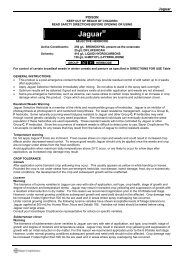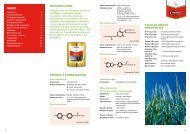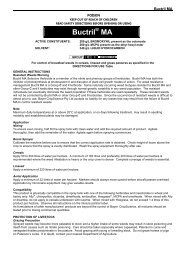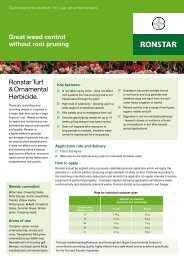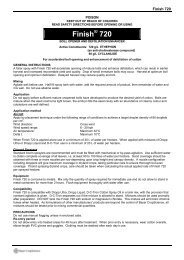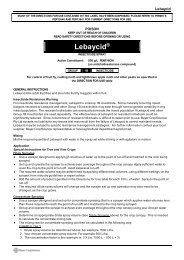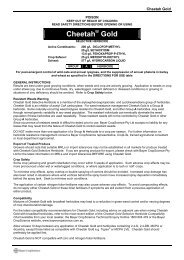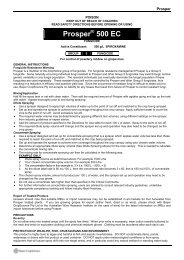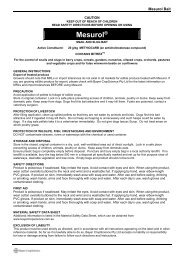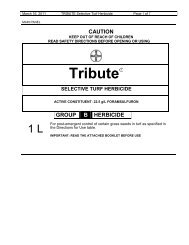Cost effective seed treatment can save your crop - Bayer CropScience
Cost effective seed treatment can save your crop - Bayer CropScience
Cost effective seed treatment can save your crop - Bayer CropScience
You also want an ePaper? Increase the reach of your titles
YUMPU automatically turns print PDFs into web optimized ePapers that Google loves.
S W<br />
what?<br />
<strong>Cost</strong> <strong>effective</strong> <strong>seed</strong> <strong>treatment</strong><br />
<strong>can</strong> <strong>save</strong> <strong>your</strong> <strong>crop</strong> from<br />
smut diseases.<br />
Of all the diseases that affect cereals,<br />
smut diseases <strong>can</strong> be the most devastating.<br />
This is because a <strong>crop</strong> <strong>can</strong>not be treated<br />
once <strong>seed</strong> is planted, and because zero or<br />
very low tolerance levels at receival centers<br />
ensures that affected grain is only sold as<br />
lower value stock feed.<br />
Dr Grant Hollaway, Senior Research<br />
Scientist with the Department of Primary<br />
Industry at Horsham, stressed to grain<br />
growers the importance of preventing this<br />
disease. He said, “Big dollars are involved.<br />
High value grain becomes lower value stock<br />
feed once smut infection has taken hold. But<br />
even though it <strong>can</strong> decimate a <strong>crop</strong>’s worth,<br />
it’s actually a disease that <strong>can</strong> be prevented<br />
very cheaply.”<br />
Dr Hollaway said, “Smuts and bunts of<br />
cereals <strong>can</strong> be very <strong>effective</strong>ly controlled by<br />
correctly applying an appropriate registered<br />
fungicide to <strong>seed</strong> every year. As there is no<br />
cure for smut diseases, prevention is the<br />
only answer.”<br />
With drought conditions affecting so<br />
many growers, every pre-season dollar must<br />
be accounted for. This means that some will<br />
choose not to treat their <strong>seed</strong> for the coming<br />
season. This strategy must be carefully<br />
weighed up against the safer alternative<br />
of treating <strong>seed</strong>, especially as it <strong>can</strong> cost<br />
from as little as $2 per hectare. In fact,<br />
treating <strong>seed</strong> could be considered cheap<br />
insurance against a <strong>crop</strong> that might end up<br />
un-saleable.<br />
Geoff Robertson, Market Manager Seed<br />
Treatments at <strong>Bayer</strong> <strong>CropScience</strong> put it<br />
another way when he explained why smut<br />
diseases <strong>can</strong> end up so costly for grain<br />
growers. He said, “If treating <strong>your</strong> <strong>seed</strong> for<br />
smut <strong>save</strong>s you once, then it has paid for<br />
itself for the next 50 years!”<br />
Geoff Robertson added, “Dollars are<br />
tight, no doubt about it. But not treating<br />
<strong>seed</strong> <strong>can</strong> cost more than treating it when<br />
all factors are taken into account. What’s<br />
worse, saving less than 1% of production<br />
costs by not treating <strong>seed</strong>, or risking yield<br />
loss, downgrading and rejection of <strong>your</strong><br />
grain?”<br />
“Dollars are tight, no doubt<br />
about it. But not treating<br />
<strong>seed</strong> <strong>can</strong> cost more than<br />
treating it . . .”<br />
Wheat, barley and oats are all susceptible<br />
to various smut diseases, and each is<br />
affected by distinct species specific to each<br />
<strong>crop</strong>. These include covered smut (bunt),<br />
loose smut and flag smut in wheat, covered<br />
smut and loose smut in barley and covered<br />
smut and loose smut in oats. In general,<br />
infection is not noticed until ear or head<br />
The pasture is always better<br />
on the Gaucho side.<br />
• Optimises productivity right from sowing,<br />
germination and early growth stage.<br />
• Protects each and every <strong>seed</strong> from read-legged<br />
earth mites and blue oat mites.<br />
• Reduces the need to spray, encouraging<br />
beneficial species to flourish.<br />
• Applied professionally and delivered on <strong>seed</strong><br />
for convenience and peace of mind.<br />
www.bayer<strong>crop</strong>science.com.au<br />
SEED TREATMENTS GUIDE<br />
P L A N T I N G S E A S O N 2 0 0 7<br />
Flag smut in wheat Loose smut in wheat<br />
emergence, when dark or black spores are<br />
seen to have replaced grain. These spores<br />
are then released at harvest, infecting and<br />
damaging the rest of the <strong>crop</strong>.<br />
Raxil® and Baytan® Seed Treatments<br />
from <strong>Bayer</strong> <strong>CropScience</strong> <strong>effective</strong>ly treat<br />
cereal smut diseases. Geoff Robertson<br />
pointed out that these <strong>seed</strong> <strong>treatment</strong>s are<br />
both cost conscious choices. He said, “Raxil<br />
is an economical smut control product in<br />
tough times. While Baytan costs a little<br />
more, it’s also extremely cost <strong>effective</strong>,<br />
as it controls smuts and bunts as well as<br />
providing suppression for foliar diseases<br />
including powdery mildew and leaf scald<br />
of barley and stripe rust and leaf blotch of<br />
wheat.”<br />
In conclusion, Geoff Robertson also<br />
offered a timely reminder to some Western<br />
Australian growers. He said, “In Western<br />
Australia in particular some growers opt for<br />
using Impact® on fertilizer for foliar disease<br />
control, but it should not be overlooked that<br />
this practice will not control smut diseases.<br />
It doesn’t make sense to spend the money<br />
up front for premium disease control and<br />
not make the small additional investment to<br />
control smuts.”
S W<br />
what?<br />
S E E D T R E A T M E N T G U I D E<br />
Stress Shield <br />
Research has identified beneficial sideeffects<br />
of imidacloprid, a <strong>seed</strong> <strong>treatment</strong><br />
insecticide used in many <strong>crop</strong>s including<br />
cereals. This side-effect has been dubbed<br />
Stress Shield, and field trials are<br />
already indicating yield increases in many<br />
locations in the absence of obvious insect<br />
pest pressure.<br />
Imidacloprid is the insecticidal active<br />
ingredient in Hombre® Cereal Seed<br />
Treatment and Zorro® Cereal Seed<br />
Treatment by <strong>Bayer</strong> <strong>CropScience</strong>, two<br />
products with strong aphid and barley<br />
yellow dwarf virus control credentials.<br />
What has now been shown is that they<br />
may also offer benefits to plant health and<br />
vigour in conditions of plant stress caused<br />
by drought, excessive heat, extremely wet<br />
conditions or sudden cold snaps.<br />
Geoff Robertson, Market Manager<br />
Seed Treatments at <strong>Bayer</strong> <strong>CropScience</strong><br />
cites the work of <strong>Bayer</strong> researchers<br />
who made the fortunate discovery. He<br />
said, “Originally the purpose of the<br />
trials was to find out how protected and<br />
unprotected plants grew when exposed<br />
to insect infestation. Our researchers were<br />
surprised to note that plants treated with<br />
imidacloprid grew much better, especially<br />
if they were subject to drought or heat<br />
stress, irrespective of whether insects<br />
were present.”<br />
Overall, Geoff Robertson said<br />
researchers were able to demonstrate<br />
that shoot and root growth in young plants<br />
were enhanced. ‘Stress Shield’ effects<br />
include a delay in the onset of the drought<br />
stress, a positive impact on the efficiency<br />
of photosynthesis, and stimulation of the<br />
plants’ own defense mechanisms against<br />
fungal disease.<br />
Mr Robertson highlighted the field<br />
performance of Hombre and Zorro in<br />
Australia. “In 41 yield observations,<br />
Hombre and Zorro gave an average<br />
yield increase of 350 kg/ha. Some of the<br />
biggest increases came from areas where<br />
the standard <strong>treatment</strong> yielded less that<br />
3.0 t/ha, or where no insect pest activity<br />
was observed.”<br />
Quenten Knight, Agronomist at<br />
Precision Agronomics Australia in<br />
Esperance, Western Australia, has been<br />
trialing Zorro for use in barley since early<br />
2002 and his own results support these<br />
findings. He said, “In the early days I saw<br />
good growth responses to Zorro even in<br />
the absence of early aphid pressure and<br />
disease. In a trial undertaken last year in<br />
a medium rainfall zone near Esperance<br />
an increase of 300 kg/ha was achieved<br />
compared to the district standard where<br />
alpha-cypermethrin was applied at the<br />
five-leaf <strong>crop</strong> stage as an aphid anti-feed.”<br />
PreDicta®B. Identifies problems. Predicts outcomes.<br />
Cereal growers now have an innovative and comprehensive root disease risk management<br />
tool. Called PreDicta B, the test is DNA-based, unlike a conventional soil nutrition test. It<br />
enables growers to detect and quantify important soil-borne pathogens that may<br />
signifi<strong>can</strong>tly reduce <strong>crop</strong> yield if not treated.<br />
Most importantly, with drought affecting soil and <strong>crop</strong> health, now’s the time to invest in a<br />
practical and cost <strong>effective</strong> tool that will assist <strong>your</strong> agronomic decision-making,<br />
including <strong>crop</strong> selection and paddock rotation. So use PreDicta B, and be sure of <strong>your</strong><br />
soil’s health BEFORE you sow.<br />
For further information call 1800 804 479.<br />
Cereal root diseases<br />
cost $200m in lost<br />
production annually.<br />
Know <strong>your</strong> soil’s<br />
health BEFORE<br />
you plant.<br />
<strong>can</strong> help increase yields.<br />
A cost-<strong>effective</strong><br />
risk management<br />
tool that really<br />
works.<br />
<strong>Bayer</strong> <strong>CropScience</strong> Pty Ltd 391-393 Tooronga Road, Hawthorn East, Vic. 3123 ABN 87 000 226 022<br />
Technical enquiries 1800 804 479 www.bayer<strong>crop</strong>science.com.au PreDicta is a registered trademark of <strong>Bayer</strong>.<br />
RRA/BAY3740<br />
Barley yellow dwarf virus affects all<br />
cereals, but is particularly prevalent in<br />
barley. Quenten Knight added, “It’s an<br />
issue in barley, especially in areas such<br />
as mine with a medium to high rainfall.<br />
Baudin is the variety most commonly<br />
grown around here, and it has shown<br />
to have had good growth responses<br />
when Zorro has been used. Compared to<br />
standard <strong>treatment</strong>s, Zorro has increased<br />
returns by $85/ha.”<br />
More work is being undertaking to<br />
support the Stress Shield findings, with<br />
the aim of further securing <strong>crop</strong> yields in<br />
the longer term.<br />
STRESS SHIELD INSIDE<br />
Top right: Seedling on left treated with<br />
Hombre and on right untreated. Compare<br />
results for <strong>your</strong>self.<br />
Bottom right: In this trial site at<br />
Esperance, Hombre yielded 320 kg/ha<br />
more than the standard <strong>treatment</strong> (Raxil).<br />
The extra profit from this was $60 /ha.<br />
The practical effect of<br />
data protection law.<br />
Many growers would be aware that<br />
the release of new active ingredients for<br />
protection of key <strong>crop</strong>s has reduced in<br />
recent years as new products become<br />
increasingly difficult to find and the cost<br />
to develop and register new compounds<br />
has escalated. This has contributed to<br />
a reduction in the number of chemical<br />
manufacturers releasing new <strong>crop</strong><br />
protection products into the Australia<br />
market.<br />
Data protection law was introduced in<br />
Australia in 2005 to encourage companies<br />
who develop agricultural chemicals to<br />
continue to develop new and improved<br />
uses for their products. The law enables<br />
unpublished data that is submitted for<br />
registration for a new <strong>crop</strong> protection<br />
product or use pattern to be protected<br />
for a period of 5 to 11 years. Other<br />
manufacturers of similar products are<br />
prevented from registering their product<br />
or inserting these new uses onto their<br />
labels unless they generate their own<br />
data, or otherwise arrange access to the<br />
protected data.<br />
For example, there are currently two<br />
commercial brands of Jockey® Fungicide<br />
– one from Crop Care, the other from<br />
<strong>Bayer</strong> <strong>CropScience</strong>. Jockey from <strong>Bayer</strong><br />
<strong>CropScience</strong> has three data protected<br />
use patterns;<br />
• it is registered in barley,<br />
• it has a registered 3.0 L/t rate in<br />
wheat, and<br />
• it has a 6 week grazing withholding<br />
period (Crop Care Jockey has a 12<br />
week grazing WHP).<br />
With the extra flexibility of Jockey from<br />
<strong>Bayer</strong> <strong>CropScience</strong>, it makes you wonder<br />
why anyone would choose Crop Care<br />
TM<br />
plant protection * better plant health * enhanced yields<br />
Jockey – especially considering both are<br />
a similar price!<br />
Data protection law provides for<br />
common law remedies if agronomists,<br />
consultants, other registrants or distributors<br />
make off-label recommendations involving<br />
protected data.<br />
Champion jockey Damien Oliver has<br />
reinforced the <strong>Bayer</strong> <strong>CropScience</strong> Jockey<br />
brand with it's 3 litre and barley claims.
P L A N T I N G S E A S O N 2 0 0 7<br />
Gaucho ®<br />
Many farmers have already adopted<br />
Gaucho® Insecticidal Seed Treatment for<br />
their clovers, lucernes and herbs. Farmers<br />
<strong>can</strong> also utilise the benefits of Gaucho in<br />
their pasture grasses, including ryegrass<br />
and fescue.<br />
In 2006, <strong>Bayer</strong> <strong>CropScience</strong> conducted<br />
commercial trials across Victoria to<br />
evaluate Gaucho use on ryegrass <strong>seed</strong>.<br />
Across 10 sites, Gaucho increased<br />
boosts ryegrass production.<br />
Improved plant growth with the Gaucho treated ryegrass compared to the untreated. High populations<br />
of RLEM, blue oat mite and lucerne flea were evident on the existing clover in the pasture.<br />
ryegrass establishment by an average of<br />
29%, and increased biomass prior to first<br />
grazing by an average of 30% compared<br />
to untreated ryegrass <strong>seed</strong>.<br />
In one trial, pasture grown from<br />
Gaucho treated <strong>seed</strong> continued to provide<br />
increased production after four successive<br />
grazings. This underlines the benefits of<br />
protecting newly sown pastures through<br />
the vulnerable early growth period.<br />
‘Over a range of varieties and sometimes<br />
in the absence of obvious insect activity,<br />
pastures grown from Gaucho treated <strong>seed</strong><br />
had better plant establishment, increased<br />
growth rates prior to first grazing and<br />
greater root development,’ explained<br />
<strong>Bayer</strong> <strong>CropScience</strong> Business Support<br />
Manager, Ken Blowers.<br />
‘This means that pastures will<br />
have improved composition, superior<br />
productivity and are more persistent,’<br />
says Ken.<br />
‘Using Gaucho on all types of pasture<br />
<strong>seed</strong> <strong>can</strong> increase profit by allowing<br />
earlier grazing of renovated pastures, by<br />
improving stocking rates or by increasing<br />
hay production.’<br />
Gaucho is professionally applied and<br />
delivered on the <strong>seed</strong> when purchased<br />
– simply request it when you order <strong>your</strong><br />
pasture <strong>seed</strong>. It protects <strong>seed</strong>lings for<br />
the critical period after germination from<br />
redlegged earth mites and blue oat<br />
mites.<br />
Gaucho is highly systemic and is<br />
rapidly absorbed by the emerging plant.<br />
This results in a rapid translocation to<br />
cotyledons and leaves. Using Gaucho<br />
treated <strong>seed</strong> reduces the need to apply<br />
post-emergent insecticides and is<br />
safe to beneficial organisms, including<br />
earthworms, when used as directed.<br />
S W<br />
what?<br />
Average percentage increase in establishment<br />
and biomass across 10 commercial trials. Lowest<br />
(-) and highest (+) recorded increases shown.<br />
Barley growers beware of leaf scald in previously resistant varieties.<br />
Leaf scald in barley is a disease that<br />
<strong>can</strong> substantially reduce <strong>crop</strong> yields when<br />
seasonal conditions are favourable for<br />
disease development. Until recent years,<br />
growers have managed the disease using<br />
a number of management strategies,<br />
including growing resistant varieties. What<br />
is extremely important to note is that the<br />
previously resistant variety, Gairdner, is<br />
now susceptible to a new strain of scald.<br />
This new strain of leaf scald was<br />
identified in Gairdner <strong>crop</strong>s growing near<br />
Hamilton in Victoria in 2000, and after a<br />
severe outbreak in 2001, has since been<br />
spreading north and east from Hamilton.<br />
Dr Grant Holloway, Senior Research<br />
Scientist at Department of Primary<br />
Industry at Horsham, warned that it’s<br />
quite an aggressive strain that <strong>can</strong> take<br />
yield and quality. He said, “This new strain<br />
is now well established in the Western<br />
District, with smaller outbreaks in the<br />
Wimmera. It’s been virulent on Gairdner,<br />
as well as other susceptible varieties<br />
including Barque and Baudin.<br />
Grant Hollaway stated that variety<br />
BCT002<br />
choice is important. He said, “Gairdner is<br />
still a good variety in many areas. Growers<br />
simply need to be aware, and protect<br />
accordingly.”<br />
Geoff Robertson, Market Manager<br />
Seed Treatments at <strong>Bayer</strong> <strong>CropScience</strong>,<br />
said that growers <strong>can</strong> stay ahead with<br />
the implementation of a multi-faceted<br />
management plan, including the use of<br />
<strong>seed</strong> <strong>treatment</strong>s, to <strong>effective</strong>ly control the<br />
disease. He said, “Destroying infected<br />
stubble <strong>can</strong> be an option. Growing barley<br />
following barley and planting susceptible<br />
varieties should be avoided too.<br />
Importantly, the use of <strong>seed</strong> <strong>treatment</strong>s is<br />
extremely <strong>effective</strong> at managing leaf scald<br />
infections in barley.”<br />
The fungicidal <strong>seed</strong> <strong>treatment</strong><br />
Jockey® by <strong>Bayer</strong> <strong>CropScience</strong> is proven<br />
to be the most <strong>effective</strong> <strong>treatment</strong> for leaf<br />
scald. Geoff Robertson added, “Jockey®<br />
is a specially formulated systemic <strong>seed</strong><br />
<strong>treatment</strong> fungicide that when used at 3.0<br />
L/t offers growers a distinct advantage<br />
against both leaf scald and powdery<br />
mildew infection.”<br />
Why smart growers make this the<br />
business end of the season<br />
Geoff Robertson also pointed out<br />
that Baytan® <strong>seed</strong> <strong>treatment</strong> fungicide<br />
by <strong>Bayer</strong> <strong>CropScience</strong> is another cost<br />
<strong>effective</strong> option, especially coming off<br />
a severe drought. He said, “Baytan®<br />
also provides excellent suppression of<br />
leaf scald in barley and is a cheaper<br />
alternative that will suit some growers<br />
better in a tight year.”<br />
As previously resistant varieties are<br />
now known to be susceptible to leaf<br />
scald, and yield loss <strong>can</strong> signifi<strong>can</strong>tly<br />
undermine profit margins, growers need<br />
to remain vigilant to the disease and<br />
ensure their management practices help<br />
control it.<br />
Yield losses due to leaf scald have<br />
been reported to be as high as 35 to 40<br />
percent, and are often between one and<br />
10 percent. Geoff Robertson concluded,<br />
“It’s such a common disease, and very<br />
costly to growers in some years. That’s<br />
why it’s so important to treat <strong>seed</strong> and<br />
mimimise its effects.”<br />
A small investment in the right <strong>seed</strong> <strong>treatment</strong> now <strong>can</strong> really pay off in extra <strong>crop</strong> quantity<br />
and quality at the other end of the season. Get <strong>your</strong> wheat, barley and oats off to a strong<br />
start with the high-powered disease protection of Baytan ® Seed Treatment.<br />
www.bayer<strong>crop</strong>science.com.au<br />
<strong>Bayer</strong> <strong>CropScience</strong> Pty Ltd, ABN 87 000 226 022, 391-393 Tooronga Road, Hawthorn East, Vic 3123.<br />
Technical Enquiries 1800 804 479 enquiries.australia@bayer<strong>crop</strong>science.com Baytan ® is a Registered Trademark of <strong>Bayer</strong>.<br />
Establishment and biomass increases with<br />
Gaucho treated ryegrass <strong>seed</strong> compared to<br />
untreated.<br />
120%<br />
100%<br />
80%<br />
60%<br />
40%<br />
20%<br />
0%<br />
Establishment Biomass<br />
In one trial, pasture<br />
grown from Gaucho<br />
treated <strong>seed</strong> continued<br />
to provide increased<br />
production after four<br />
successive grazings.<br />
Geoff Robertson advising growers to<br />
beware of resistant varieties.
S W<br />
what?<br />
S E E D T R E A T M E N T G U I D E<br />
Canola growers beware<br />
of blackleg in 2007.<br />
As <strong>can</strong>ola growers know, blackleg is a<br />
debilitating fungal disease that is costly to<br />
both individual growers and the industry<br />
as a whole. What is also important to<br />
know is that planting this season’s <strong>can</strong>ola<br />
in the same paddocks as last year’s failed<br />
<strong>crop</strong>s increases the risk of infection from<br />
remaining stubble.<br />
An integrated approach to resistance<br />
management is an important aspect in the<br />
control of blackleg. This includes growing<br />
resistant <strong>can</strong>ola varieties, rotating <strong>crop</strong>s<br />
and using fungicides when necessary.<br />
Dr Steve Marcroft, of Marcroft Grains<br />
Pathology, stressed the importance of<br />
an integrated approach. He said, “Good<br />
management is the best defense against<br />
blackleg. With less stubble after a failed<br />
drought affected <strong>crop</strong>, some growers are<br />
considering sowing <strong>can</strong>ola on <strong>can</strong>ola,<br />
as these paddocks are set up and ready<br />
to go. I urge them to avoid this, as yield<br />
losses <strong>can</strong> increase.”<br />
A vital part of an integrated approach<br />
is using an <strong>effective</strong> fungicide such as<br />
Jockey® Systemic Seed Fungicide by<br />
<strong>Bayer</strong> Crop Science.<br />
Geoff Robertson, Market Manager<br />
Seed Treatments at <strong>Bayer</strong> <strong>CropScience</strong>,<br />
outlined some important aspects of<br />
<strong>can</strong>ola management. He said, “Isolating<br />
this year’s <strong>crop</strong> from last year’s stubble is<br />
extremely important, but so is choosing<br />
a suitable variety. Some of the highest<br />
yielding triazine tolerant, Clearfield, and<br />
conventional varieties have a blackleg<br />
resistance less than 7 out of 10. Trial<br />
work has shown that growers should use<br />
Jockey on these varieties to suppress<br />
blackleg and maximise yields.”<br />
“In many situations, especially those<br />
of high disease risk such as this year’s<br />
summer volunteers starting early blackleg<br />
spore release, <strong>seed</strong> <strong>treatment</strong> with<br />
Jockey offers growers added insurance<br />
in varieties with a rating of greater than 7<br />
out of 10.”<br />
Geoff Robertson also pointed out<br />
that compared to applying a fungicide<br />
to fertiliser, <strong>seed</strong> <strong>treatment</strong> with Jockey<br />
gives growers comparable control at a<br />
lower cost and greater flexibility.<br />
Avoiding planting this year’s <strong>crop</strong> in<br />
last year’s <strong>can</strong>ola paddocks and leaving<br />
500 metres between this year’s <strong>crop</strong><br />
and last year’s stubble are industry<br />
wide recommendations. Growers should<br />
always check the current year’s blackleg<br />
resistance ratings before choosing to<br />
plant a variety that is suited to their<br />
rainfall and farming system, and monitor<br />
their <strong>crop</strong> for blackleg severity each year.<br />
It is by combining all these strategies that<br />
individual growers and the entire <strong>can</strong>ola<br />
industry are best equipped to manage<br />
blackleg now and into the future.<br />
In conclusion, Steve Marcroft said<br />
some growers may be less vigilant<br />
post drought, but that in reality, they<br />
shouldn’t be. He said, “Cutting corners<br />
<strong>can</strong> mean coming unstuck. Therefore, it’s<br />
vitally important to manage all aspects of<br />
blackleg control.”<br />
“Cutting corners <strong>can</strong><br />
mean coming unstuck.<br />
Therefore, it’s vitally<br />
important to manage<br />
all aspects of blackleg<br />
control.”<br />
The benefits of blackleg control from<br />
Jockey (right) is clearly evident compared<br />
to untreated <strong>can</strong>ola (left).<br />
Vigilance is needed to control stripe rust, including new strain.<br />
While stripe rust was not a signifi<strong>can</strong>t<br />
problem for cereal growers in 2006, past<br />
experience suggests that post drought<br />
conditions <strong>can</strong> lead to an increase in<br />
outbreaks. Also, the detection of a new<br />
strain of stripe rust that could potentially<br />
undermine and overcome resistance in<br />
some varieties means growers must be<br />
on–the-alert this coming season.<br />
Until now the Yr17 gene has been<br />
a major defence against stripe rust for<br />
Photo: 112 days after sowing<br />
Untreated Jockey at 4.5L/tonne<br />
varieties grown in New South Wales<br />
including Carinya, Ellision, Marombi,<br />
Sunbri, Sunlin, Sunstate, Sunvale and<br />
Ventura.<br />
Colin Wellings, Principal Research<br />
Pathologist at the University of Sydney,<br />
explained the potential consequences.<br />
He said, “New strains sometimes persist<br />
and sometimes they don’t. Conditions<br />
need to be right. This new strain has<br />
the ability to overcome the Yr17 gene,<br />
potentially reducing resistance in some<br />
varieties. It could be damaging if it has<br />
survived the summer. If this is the case,<br />
and it persists into the early phase of<br />
the growing season, this is the time it is<br />
potentially at its most harmful.”<br />
As is the same with many diseases,<br />
a careful management plan throughout<br />
the growing season offers growers the<br />
best way to minimise risk to <strong>crop</strong> health<br />
and yield.<br />
For stripe rust suppression, choosing<br />
a wheat variety with good rust resistance<br />
for the particular target region is certainly<br />
an important step. Also included in<br />
growers’ management plans should be<br />
the control of volunteer wheat plants over<br />
summer and autumn, the use of fungicide<br />
<strong>treatment</strong> in high risk areas and on the<br />
more susceptible varieties, and on-going<br />
in-<strong>crop</strong> monitoring right throughout the<br />
growing season.<br />
Colin Wellings stressed the importance<br />
of variety choice. He said. “A variety with<br />
at least a moderate resistance rating<br />
is a prudent decision. If a risk is taken<br />
with the variety chosen, then growers<br />
must be prepared to commit to on-going<br />
monitoring and take appropriate and<br />
timely action.”<br />
Jockey® Systemic Seed Fungicide<br />
by <strong>Bayer</strong> <strong>CropScience</strong> is proven to<br />
control stripe rust for up to five weeks<br />
after sowing with <strong>effective</strong> suppression<br />
thereafter at the new 3 L/t rate. Ben Smith,<br />
Business Manager Seed Treatments at<br />
<strong>Bayer</strong> <strong>CropScience</strong> explained further. He<br />
said, “Jockey is a specially formulated<br />
systemic <strong>seed</strong> <strong>treatment</strong> fungicide that<br />
when used at the new 3 L/t rate has been<br />
proven to signifi<strong>can</strong>tly reduce stripe rust<br />
infection at flag leaf emergence. The new<br />
rate offers growers more flexibility, and<br />
most importantly, is cost <strong>effective</strong>.”<br />
Ben Smith suggested that Baytan®<br />
Seed Treatment by <strong>Bayer</strong> <strong>CropScience</strong><br />
is also an option for cost <strong>effective</strong><br />
suppression of <strong>seed</strong>ling infections. He<br />
said, “Coming out of a drought means<br />
every penny counts. Baytan is a cheaper<br />
alternative and in certain circumstances is<br />
an option worth considering.”<br />
As the battle against cereal rusts,<br />
including stripe rust, continues to affect<br />
the grains industry, especially with the<br />
emergence of new strains such as the<br />
current West Australian pathotype, all<br />
growers need on-going vigilance and have<br />
<strong>effective</strong> management plans in place.<br />
Ben Smith concluded, “Dry conditions<br />
kept stripe rust off the agenda in 2006,<br />
but as 2002 and 2003 experiences show,<br />
a post drought outbreak is possible. I<br />
therefore urge growers to pay careful<br />
attention to fungal diseases such as stripe<br />
rust this season.”<br />
One Jockey.<br />
Two new claims.<br />
COST EFFECTIVE<br />
3 LITRE RATE<br />
Jockey® is now registered for use at<br />
3.0 L/tonne, providing a cost <strong>effective</strong><br />
alternative for foliar disease control in<br />
wheat when take-all suppression is not<br />
required.<br />
NOW REGISTERED<br />
FOR BARLEY<br />
Jockey Systemic Seed Fungicide is the<br />
most <strong>effective</strong> <strong>seed</strong> <strong>treatment</strong> for leaf<br />
scald and powdery mildew control in<br />
barley.<br />
Two more reasons why there is only one Jockey. The proven<br />
winner against fungal diseases in wheat, <strong>can</strong>ola and now barley.<br />
<strong>Bayer</strong> <strong>CropScience</strong> Pty Ltd 391-393 Tooronga Road, Hawthorn East, Vic. 3123 ABN 87 000 226 022<br />
Technical enquiries 1800 804 479 www.bayer<strong>crop</strong>science.com.au Jockey® is a registered trademark of <strong>Bayer</strong>.<br />
RRA/BAY4172



